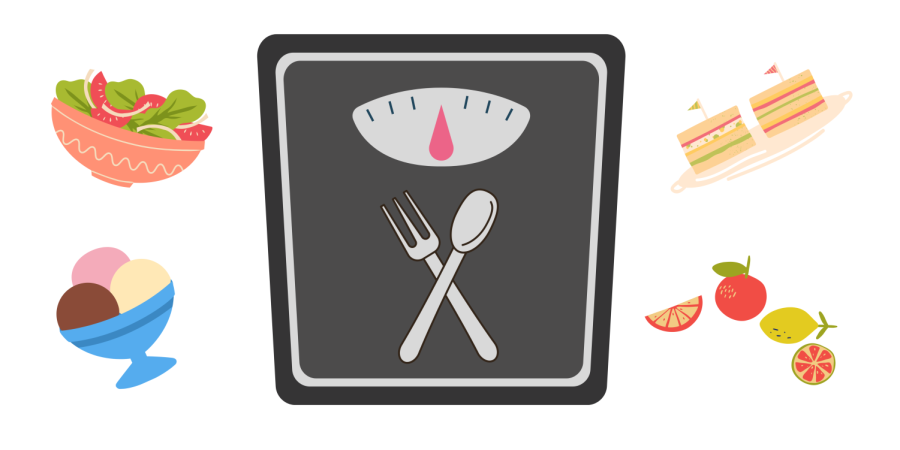Submitted: Eating disorders in college students
March 4, 2022
Julianna Lowe, an English and Political Science major who graduated Fall 2021, said an average day of food during her freshman year consisted of: no breakfast, a head of lettuce for lunch, and a low-calorie snack at five.
“I had no energy to do anything. I was only awake for probably eight or ten hours at a time,” Lowe said. “I was skipping classes because I would get dizzy and feel like I was going to faint.”
Lowe wouldn’t eat out with her friends, saying she didn’t like to eat. Lowe’s disordered eating caused her to lose weight over the course of a year, and eventually, her hair.
“I think what kind of switched that for me was I did like the way that I looked for a long time, but then I saw a picture of myself and I was like ‘I don’t look good,’” Lowe said. “I looked unhealthy.”
Mia Edwards, a freshman from Simpsonville, KY, was also scared into recovery from bulimia after a visit to the dentist, who told her the enamel on her teeth had been severely depleted.
“My dentist was asking me, ‘Do you eat a bunch of oranges, like anything with a lot of acid in it?’” Edwards said. “But what really was going on was the stomach acid coming up was starting to erode my teeth. Now I have calcium spots.”
The National Institute of Mental Health (NIH) defines three main types of eating disorders: anorexia nervosa, bulimia nervosa, and binge-eating disorder.
“Anorexia nervosa is a condition where people avoid food, severely restrict food, or eat very small quantities of only certain foods,” NIH said. “Bulimia nervosa is a condition where people have recurrent and frequent episodes of eating unusually large amounts of food and feeling a lack of control over these episodes. This binge-eating is followed by behavior that compensates for the overeating such as forced vomiting, excessive use of laxatives or diuretics, fasting, excessive exercise, or a combination of these behaviors.”
Binge-eating disorder is similar to bulimia, but the NIH said it is not followed by purging, excessive exercise, or fasting.
Lowe’s disordered eating didn’t begin until college. She encountered new challenges related to comparison, maintaining a new schedule, having new total control over what she ate, and dealing with the overwhelming desire to be admired by new people.
“I had been used to how I looked to the girls growing up with me in my small town,” said Lowe. “There wasn’t really that comparison aspect, but when I came to college, it was all these new girls who I had never seen before and I was like ‘Okay, I don’t look like the girls that people like so I need to start looking like them. Right?’”
Madalyn Stack, an English and Graphic design major who graduated Spring 2021, said the crushing comparisons of college contributed to her eating disorder.
“When I went to WKU, I felt like I was on an island,” Stack said. “I was surrounded by people my age, and you don’t really see anyone other than 18- to 21-year-olds. I feel like there’s so much comparison going on. And with social media, a lot of people retouch their pictures nowadays. You’re comparing yourself to something that you can’t even achieve.”
In the college culture and lifestyle, Stack noticed that many girls around her were struggling with disordered eating, although they didn’t seem to realize it.
“I was always hearing, my whole time in college, girls talking about not eating a few days before a party so they could get drunker or so their clothes would look better on them,” Stack said. “A lot of people around me in my life are always talking about dieting, and like not wanting to gain weight and just being very body conscious.”
Once in recovery, Lowe started to notice that disordered eating was everywhere she looked. People didn’t seem to realize the harmful impacts of dieting trends, such as keto and intermediate fasting, because it is so widely accepted in our culture.
“All of this stuff, where you are restricting what you eat, and you are not giving your body what it needs and what it’s asking you for—that is not healthy eating,” Lowe said.
Lowe said that the romanization of limited eating in college culture also contributes to disordered eating.
“College has a huge culture of not eating because you’re too busy or only eating one thing a day because you have too much going on,” Lowe said. “But self care definitely should come first. Your body is not going to be able to make it through all nighters or through four years without you nurturing it.”
Similar to how Stack struggled with unrealistic standards on social media, Lowe’s mental health worsened due to comparing herself to social media influencers.
“I became a huge Kylie Jenner fan,” Lowe said. “I was obsessed with Kylie and how fast she snapped back from her pregnancy, which was of course because of surgery and all the money she has. I was like, ‘I haven’t even ever been pregnant and I don’t look the way she does.’ I also compared myself to girls that had the lives I wanted to have, and associated that with body image.”
Reluctant to give up social media completely because it was so integrated within Gen-Z culture, she learned how to live with it, but in a healthy way, Lowe said.
“I started following influencers that were body positive and focused on eating disorder recovery, like Brittani Lancaster and Victoria Garrick,” Lowe said. “Those people helped me a lot in realizing that I wasn’t alone and that a huge part of recovery is to listen to your body. They paved the way for me to understand I can be a person that people like and be healthy at the same time.”
Lowe said she not only found solace in hearing about other people’s stories, but also by sharing her story on Instagram.
“I got a lot of positive feedback,” Lowe said. “People texted me and said, ‘Thank you so much for opening up about that, and it was really important that you did because nobody talks about it.’ It was so crazy to see these girls that I’ve been comparing myself to were dealing with the same things as me. You don’t ever know what somebody is going through.”
Lowe recognizes a problem with representation in the discussion about eating disorders.
“All the influencers that I follow on social media are young, white women like me, and that’s probably partially because of my algorithm,” Lowe said. “But it’s also partially because it’s becoming sort of acceptable in our society for those women to talk about it. I haven’t really encountered a lot of diversity in opening up about eating disorders, recovery or anything like that. So, I don’t want people to get it in their heads that this is the only type of person that struggles with it, because it’s not.”
Stack also believes that there is a problem with how our culture represents eating disorders.
“I think a lot of people don’t take eating disorders seriously unless the person is super sick or thin,” Stack said. “People look at bigger people or healthy-looking people and think, ‘Oh, that person’s healthy and they don’t have an eating disorder,’ but it can literally look like anything at all.”
Edwards felt like the new freedom to eat, diet, and workout in college, along with the restriction of meal swipes, were contributing factors to her eating disorder.
“Let’s say you have a specific dietary preference, like vegetarianism, and you go to Chick-fil-A,” Edwards said. “You can get a fruit cup and fries but that’s not filling and that can definitely contribute to eating disorders because you’re just not getting enough.”
Calories and numbers related to weight, Lowe said, is triggering for people who have or are struggling with an eating disorder.
“If somebody is sharing how much they weigh, people with eating disorders have a huge fixation on that,” Lowe said. “They’re like ‘Oh, I weigh less than that, so I’m doing good, or I weigh more than that I’m doing bad.’ The same thing with calories. Calories are a made-up way to measure food that doesn’t even make sense.”
In recovery, Lowe still experiences lingering trauma related to numbers and feels she always will.
“Calorie numbers are engraved into my brain of foods that I used to eat and still enjoy today,” Lowe said. “I have a subconscious tendency to only go to restaurants where I know that they have nutrition facts posted, and I have a hard time getting myself to enjoy sweets without binging on them.”
A big misconception about eating disorders is that there is a simple solution, Stack said.
“I think that a lot of people don’t realize that you’re not in your right mind,” Stack said. “So many times when I’ll try to talk about it, people would be like, ‘well, you need food, like, your organs could fail.’ And when you have an eating disorder, you know all that. [Your eating disorder] becomes such a priority that you don’t really care what kind of danger you’re putting yourself in. You don’t care about what’s real.”
Similar to how there is no simple solution, there is no simple cause either, said Lowe.
“Just because I struggle with it because of my physical appearance doesn’t mean that everyone struggles with it because of that,” Lowe said. “It’s like any other mental illness. It doesn’t have to be caused by something. It doesn’t have to be a chain reaction. It can just be something that you have developed over time. It’s not really a cause and effect type thing. It’s much more complex than what the narrative has become in society.”
The road to recovery for Lowe, Stack, and Edwards were all lined with support from loved ones.
“My boyfriend was thankfully raised by parents who gave him a really healthy idea of body image and food security,” Lowe said. “I didn’t realize I was doing anything wrong with my relationship with food, and he helped me realize that. I guess a strategy for recovery is to listen to the people who are trying to look out for you.”
“Bailey Cooke is my best friend and no matter what I’ve done or what weight I’ve been at, she’s always been there,” Stack said. “She doesn’t offer me simple solutions because she knows it’s deeper than that. I feel like she’s never been scared to hear me talk about it.”
“My friend also has an eating disorder,” Edwards said. “What she and I like to do is cook together. It’s really healing because you’re putting work into it and focusing on what is filling rather than how many calories something has in it.”
Above all, practicing intuitive eating has helped Lowe, Edwards, and Slack in their recovery process.
Nourish defines intuitive eating as “trusting your inner body wisdom to make choices around food that feel good in your body, without judgment and without influence from diet culture.”
“If you just listen to your body, you’ll know what it needs,” Lowe said. “Your body will tell you. We are animals and it is in our nature to need to eat and nurture ourselves. I think it’s very important that we learn to listen to our bodies and not what society is encouraging us to do.”
Kayla Spears can be reached through email at [email protected]






















